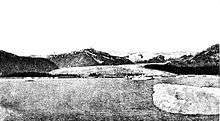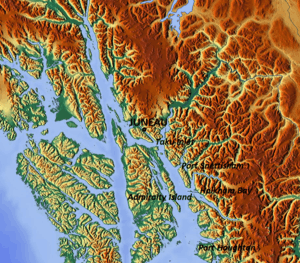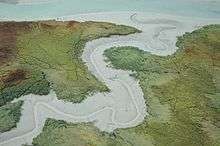Taku Inlet
Taku Inlet is an inlet located in the U.S. state of Alaska. It extends 18 miles (29 km) in a northeast direction from Stephens Passage in the Alexander Archipelago, about 12 kilometres (7.5 mi) southeast of Juneau, widening to a basin where discharge from the Taku River and Taku Glacier emerges.[1]



Geography

Taku Inlet is suitable for use only for shallow draft river boats, as it is shallow in depth and is a “cul-de-sac”. Taku Glacier is located at the head of this inlet. Since 1890, the glacier had moved by some 3 miles (4.8 km) into the Taku Inlet. As a result of the rapid movement of the glacier, silting has occurred at the head of the inlet. However, a clear channel exists between Taku Point and the Norris Glacier moraine, 1.25 miles (2.01 km) wide, with a depth of above 10 fathoms. A complete preliminary navigational chart, to a scale of 1:10,000, has been prepared by field surveys, to facilitate interested navigators to operate ships to view the glaciers.[2] Scow Cove, Sunny Cove, Annex Peak, and Annex Lakes are some of its geographical features on its western side. On the eastern side of the inlet is Turner Lake, Bart Lake and Lake Dorothy.
Norris, Taku, Hole-in–the-Wall, Twin and Tulsequah glaciers emerge out on the southeastern side and flow into the trench of the Taku Inlet and Taku River.[3] Two ice-streams join here to form a fan slope, ending in a terminal moraine. The sandy level of the moraine is cut by several watercourses; crimson epilobium blanket the beds of moraine.[1]
Fauna
.jpeg)
Many bears, wolves, and killer whales are found in the area. Halibut and crabs are commercially harvested in Taku Inlet.[1]
References
- Scidmore, Eliza Ruhamah (1896). Appletons' Guide-book to Alaska and the Northwest Coast: Including the Shores of Washington, British Columbia, Southeastern Alaska, the Aleutian and the Seal Islands, the Bering and the Arctic Coasts (Public domain ed.). D. Appleton. pp. 80–. Retrieved 11 January 2013.
- George E. Morris, Jr. "The Resurvey of Taku Inlet". U. S. Coast and Geodetic Survey. National Oceanic & Atmospheric Administration (NOAA), NOAA Central Library. Retrieved 13 January 2023. Check date values in:
|accessdate=(help) - Muntz, Alfred Philip (1955). "Recent Glacier Activity in the Taku Inlet Area, South Eastern Alaska". ARCTIC, North America. 8 (2): 83–95. Retrieved 13 January 2013.